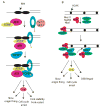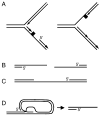ATR: an essential regulator of genome integrity
- PMID: 18594563
- PMCID: PMC2663384
- DOI: 10.1038/nrm2450
ATR: an essential regulator of genome integrity
Abstract
Genome maintenance is a constant concern for cells, and a coordinated response to DNA damage is required to maintain cellular viability and prevent disease. The ataxia-telangiectasia mutated (ATM) and ATM and RAD3-related (ATR) protein kinases act as master regulators of the DNA-damage response by signalling to control cell-cycle transitions, DNA replication, DNA repair and apoptosis. Recent studies have provided new insights into the mechanisms that control ATR activation, have helped to explain the overlapping but non-redundant activities of ATR and ATM in DNA-damage signalling, and have clarified the crucial functions of ATR in maintaining genome integrity.
Figures




References
-
- Cortez D, Guntuku S, Qin J, Elledge SJ. ATR and ATRIP: partners in checkpoint signaling. Science. 2001;294:1713–6. Identified ATRIP and along with reference 129 demonstrated that ATR is essential for cell viability. - PubMed
-
- de Klein A, et al. Targeted disruption of the cell-cycle checkpoint gene ATR leads to early embryonic lethality in mice. Curr Biol. 2000;10:479–82. - PubMed
-
- Nyberg KA, Michelson RJ, Putnam CW, Weinert TA. Toward maintaining the genome: DNA damage and replication checkpoints. Annu Rev Genet. 2002;36:617–56. - PubMed
-
- Shechter D, Costanzo V, Gautier J. Regulation of DNA replication by ATR: signaling in response to DNA intermediates. DNA Repair (Amst) 2004;3:901–8. - PubMed
Publication types
MeSH terms
Substances
Grants and funding
LinkOut - more resources
Full Text Sources
Other Literature Sources
Research Materials
Miscellaneous

